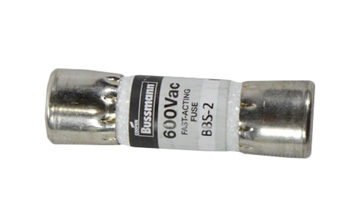Generators are powerful machines that give you confidence that you’ll have a steady supply of electricity when your power goes out, you are on a job site without traditional hookups, or you are hosting an off-the-grid event. With great power comes great responsibility, and keeping yourself and your equipment safe is paramount when dealing with electric power.
Your portable or standby generator has several safety mechanisms in place. Generac generator fuses are one example of safety measures taken by manufacturers to ensure the electricity generated does not become dangerous. Knowing how fuses work and the steps necessary to install one of these Generac replacement parts will give you confidence to safely run your machine.
What Is a Generator Fuse?
 Fuses are an important part of many electrical systems. They are one of the primary defenses against dangerous electrical problems that could harm equipment or start a fire, which is why Generac generator fuses are essential for your generator’s and your household’s safety.
Fuses are an important part of many electrical systems. They are one of the primary defenses against dangerous electrical problems that could harm equipment or start a fire, which is why Generac generator fuses are essential for your generator’s and your household’s safety.
In the simplest terms, a fuse is a safety device that provides overcurrent protection in electric circuits. These small yet vital elements can sense too much electrical current and break it to prevent overload.
Fuses vs. Circuit Breakers
Circuit breakers and fuses serve the same purpose, protecting against runaway electricity, but there are several key differences between the two. Circuit breakers often use an electromagnet to sense the flow of electricity, and a spring-loaded switch trips the breaker and kills the current if needed, while the fuse itself breaks to stop the current. Fuses and circuit breakers are both used in generators, and Generac generator fuses provide as much protection as a typical circuit breaker.
What Do Generac Generator Fuses Do?
Protecting your generator and home are the key functions of generator fuses. When studying how a generator works, it is important to note that fuses are an essential element, and it is helpful to have these Generac replacement parts on hand if your generator fuses are blown.
Generac generator fuses contain a metal filament within a glass or ceramic casing. The electric current goes over the filament as it enters the circuit. That filament can only handle a certain level of current, and if the current load that goes through the fuse is too great, the filament will melt. This opens the circuit so that power cannot flow anymore.
Both standby generators and portable generators have fuses. In portable generators, fuses can be found in the control panel or other electrical compartments. When looking at a standby generator, fuses can be found in the automatic transfer switch to protect the generator and whatever you have plugged into it.
The Purpose of a Generator Automatic Transfer Switch
The automatic transfer switch is a logical place to house a fuse that monitors electrical current. Acting as a bridge between the power grid and your standby generator, the automatic transfer switch seamlessly transfers power during an outage. Some of the switch’s primary functions include:
- Automatic power transfer
- Load shedding
- Monitoring voltage
- Return to the main power grid when necessary
 Because the automatic transfer switch is an important component with electricity flowing through it, having a Generac transfer switch fuse is vital to your safety and to shield your generator from excessive electrical current.
Because the automatic transfer switch is an important component with electricity flowing through it, having a Generac transfer switch fuse is vital to your safety and to shield your generator from excessive electrical current.
Fuses and Your Generator’s Maintenance
As mentioned above, when fuses sense too much electrical current, the filament inside breaks and is no longer effective. A fuse with a broken filament is considered a blown generator fuse, and the electrical circuit is broken, meaning your generator will not work until an intact Generac generator fuse is installed.
Blown generator fuses must be checked and changed if necessary as a part of regular generator maintenance. In fact, fuses are common Generac replacement parts, making them easy to find and replace. By changing your fuses, you ensure your generator is working safely.
When to Change Generac Generator Fuses
Generally, it will be obvious when you need to replace one of your Generac generator fuses. If your generator or automatic transfer switch is not working properly, checking to see if the fuse is intact or blown could lead to an easy repair.
It is wise to conduct regular generator maintenance, which should include checking your fuses. Like other components, fuses have finite lifespans, and it is helpful to have these Generac replacement parts on hand for quick replacement when needed.
How Do You Change Generac Generator Fuses?
Once you know you have to change a fuse and have obtained the correct Generac replacement part, conducting the repair is easy:
- Turn off the generator
- Disconnect the power supply
- Locate the blown fuse using the generator diagnostic manual if needed
- Open the access panel if present
- Remove the blown fuse, adjusting clips or removing screws if necessary
- Confirm your Generac replacement part matches the old fuse amperage rating
- Install your Generac replacement part, making sure it is seated properly
- Reassemble the access panel
- Reconnect the power supply
- Test the generator
When changing your Generac generator fuses, always wear insulated gloves and ensure the machine is off and disconnected from power. This will reduce the risk of injury during your repair.
Purchasing Generac Replacement Parts
 Finding replacement generator fuses is easy when shopping with knowledgeable suppliers that sell genuine OEM parts. By purchasing OEM fuses, you know you are using parts made specifically for your generator.
Finding replacement generator fuses is easy when shopping with knowledgeable suppliers that sell genuine OEM parts. By purchasing OEM fuses, you know you are using parts made specifically for your generator.
Fuses are often found in specially curated Generac maintenance kits, giving you confidence that you have the correct Generac replacement parts for every step of your regular generator upkeep. With these key parts on hand, you can be prepared for any blown fuse or faulty circuit. The foresight to have Generac replacement parts ready at a moment’s notice will ensure your generator is fully functional whenever an emergency strikes.
By knowing what fuses do, how to recognize when one is blown, and how to replace a blown fuse, you can keep your generator running and your house and equipment safe. Fuses are vital safety components, and educating yourself on their upkeep makes you a responsible generator owner.

